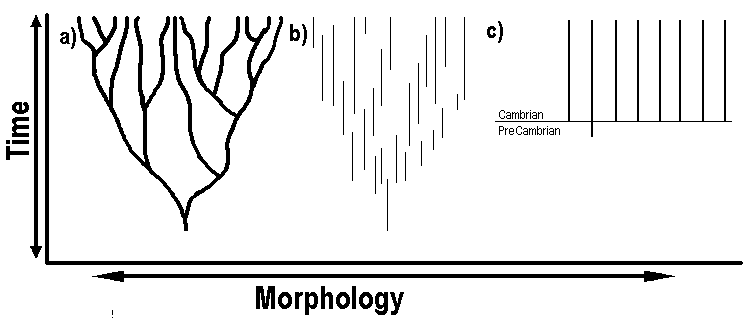Darwinism predicts that there should be intermediate stages in the evolution of life between the ancestral form of an organism and its presumed descendent. These “transitional forms” or “missing links,” however, are usually absent. Charles Darwin said in
The Origin of Species:
...The number of intermediate varieties, which have formerly existed on the earth, [must] be truly enormous. Why then is not every geological formation and every stratum full of such intermediate links? Geology assuredly does not reveal any such finely graduated organic chain; and this, perhaps, is the most obvious and gravest objection which can be urged against my theory.

Fossils are the hardened remains of organisms. The “fossil record” is the collective types of fossils that have been discovered by paleontologists.
|
Out of tens of thousands of species known from the fossil record, only a few are claimed to be any of Darwin's “intermediate links.” However, a close analysis of these few fossils (commonly cited ones are
Archaeopteryx [a bird],
Ambulocetus [a land mammal],
Acanthostega [an amphibian]), and
Tiktaalik [a fish]) reveal that they do not shed any light on the origin of the important features of their respective groups and are often incomplete. In addition, the presumption that they are ancestral is based on morphological considerations (like saying a laptop evolved from a pizza box), which does not acknowledge the massive gene coding changes that would be necessary. For this reason, Harvard paleontologist, the late Stephen Jay Gould, wrote:
The history of most fossil species includes two features particularly inconsistent with gradualism: 1. Stasis. Most species exhibit no directional change during their tenure on earth. They appear in the fossil record looking much the same as when they disappear; morphological change is usually limited and directionless. 2. Sudden appearance. In any local area, a species does not arise gradually by the steady transformation of its ancestors; it appears all at once and 'fully formed.'
Dr. Gould proposed a theory called "Punctuated Equilibrium," implying that “transitional forms” were unlikely to be fossilized because transitions occurred rapidly in small populations. However punctuated equilibrium does not fit with what is known of genetics. Too much biological complexity must be built into too few generations. Darwin’s notion of long periods of time allowing for complex changes of biology is not taken into account in Punctuated Equilibrium. The lack of transitional forms remains a big problem for Darwin’s theory.

This diagram illustrates the lack of transitional forms in the fossil record. The vertical axis represents time, and the horizontal axis represents “morphology” (body structure of an organism). Darwin’s theory (a) predicted that fossil transitions between different body types would be found. When transitions were not found, evolutionists proposed hypothetical model (b), punctuated equilibrium, where the transitional forms were not fossilized. Model (C) represents the actual fossil record with regards to the origin of the major types (phyla) of animals. Many types of organisms suddenly appear in the “Cambrian” period. This “Cambrian Explosions”, combined with the Avalon Explosion and the sudden appearance of Angiosperms (Frohlich and Chase, 2007) provide good examples of the many explosions challenging those seeking evidence for evolution in the fossil record. |
